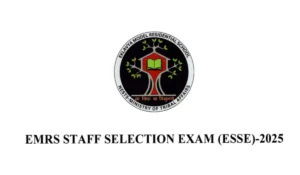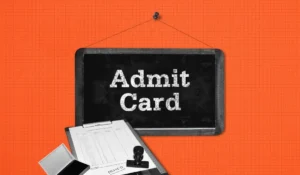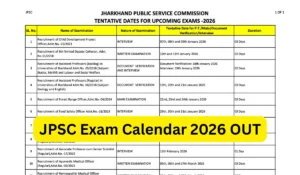The Indian Coast Guard (ICG) is India’s maritime law enforcement and search and rescue agency that operates under the Ministry of Defence. The primary role of the Indian Coast Guard is to safeguard the country’s maritime in various aspects. The ICG conducts the Indian Coast Guard Recruitment Exam to recruit candidates for the posts of Navik (General Duty), Navik (Domestic Branch), and Yantrikin the Indian Coast Guard. Candidates interested in the Indian Coast Guard exam must check out the latest Indian Coast Guard Syllabus 2025 to prepare effectively for the exam.
Indian Coast Guard Syllabus and Exam Pattern 2025
The knowledge of the Indian Coast Guard Syllabus 2025 for Navik and Yantrik is the first step for beginning the preparation. Aspirants must check the latest Indian Coast Guard Syllabus and Exam Pattern 2025 to get familiar with the marking scheme, maximum marks, and question format as specified by the commission.
| Indian Coast Guard Syllabus 2025 | |
| Organization | Indian Coast Guard (ICG) |
| Exam Name | Indian Coast Guard Exam 2025 |
| Exam Level | National Level |
| Category | Syllabus |
| Type of Questions | Multiple Choice Questions |
| Mode of Exam | Online |
| Selection Process | Stage I – Computer Based Test Stage II- Assessment & Adaptability Test, Physical Fitness Test, Document Verification and Initial Medicals Examination Stage III- Document Verification and Final Medical Examination at INS Chilka Stage IV- The candidates will undergo training at INS Chilkaare. |
| Official Website | www.indiancoastguard.gov.in |
Indian Coast Guard Navik Exam Pattern 2025
The first step to prepare for the Indian Coast Guard Exam is to understand the Indian Coast Guard Exam Pattern 2025, the types of questions asked, and the marking scheme to plan their preparation accordingly to the Exam Pattern. Candidates who want to apply for Navik DB posts must undergo Section I whereas those who want to apply for Navik GD must undergo Section (I+II).
| Indian Coast Guard Navik Exam Pattern 2025 | ||||
| Section | Subject | No. of Questions | Total Marks | Duration |
| Section I | Maths | 20 | 20 | 45 mins |
| Science | 10 | 10 | ||
| English | 15 | 15 | ||
| Reasoning | 10 | 10 | ||
| GK | 5 | 5 | ||
| Section II | Maths | 25 | 25 | 30 mins |
| Physics | 25 | 25 | ||
Indian Coast Guard Navik Syllabus 2025
For the candidates’ reference, we have tabulated below the details of the Indian Coast Guard Navik Syllabus 2025.
| Indian Coast Guard Navik Syllabus 2025 (General Duty) |
| Section I |
|
| Indian Coast Guard Navik Syllabus 2025 (General Duty) |
| Section II |
Physics
|
Mathematics
|
| Indian Coast Guard Navik Syllabus 2025 (Domestic Branch) |
| Section I |
|
Indian Coast Guard Yantrik Exam Pattern 2025
To appear for the Indian Coast Guard Yantrik Exam, candidates must be aware of the details of Indian Coast Guard Yantrik Exam Pattern 2025. Section one includes a written examination which is compulsory for all posts and depending upon the posts candidates are willing to apply for applicants need to appear section separately.
| Posts | Written test |
| Navik GD | Section I |
| Navik DB | Section (I+II) |
| Yantric (Electricals) | Section (I+III) |
| Yantrik (Electronic) | Section (I+IV) |
| Yantrik (Mechanical) | Section (I+V) |
The detailed Indian Coast Guard Navik Exam Pattern 2025 is tabulated below.
| Indian Coast Guard Navik Exam Pattern 2025 | ||||
| Section | Subject | No. of Questions | Total Marks | Duration |
| Section I | Maths | 20 | 20 | 45 mins |
| Science | 10 | 10 | ||
| English | 15 | 15 | ||
| Reasoning | 10 | 10 | ||
| GK | 5 | 5 | ||
| Section II | Maths | 25 | 25 | 30 mins |
| Physics | 25 | 25 | ||
| Section III | Electrical Engineering |
50 | 50 | 30 mins |
| Section IV | Electronic Engineering |
50 | 50 | 30 mins |
| Section V | Mechanical Engineering | 50 | 50 | 30 mins |
Indian Coast Guard Yantrik Syllabus 2025
The Indian Coast Guard Yantrik Syllabus 2025 has been detailed in the table below. For a full-proof preparation strategy, the aspirants must have a thorough awareness of the syllabus topics for the examination. The syllabus for Sections I and II is similar to that of the Indian Coast Guard Navik Syllabus.
| Indian Coast Guard Yantrik Syllabus 2025 |
| Section III |
| Electrical Diploma Engineering |
|
| Indian Coast Guard Yantrik Syllabus 2025 |
| Section IV |
| Electronics Diploma Engineering |
| Basic concepts- Concepts of resistance, inductance, capacitance, and various factors affecting them. Concepts of current, voltage, power, energy and their units.
Electronic Components & Materials- Conductors, Semi conductor& Insulators; Magnetic materials; Jointing & Cleaning materials for U/G copper cable & OFC; Cells and Batteries (chargeable and non chargeable); Relays, Switches, MCB & Connectors. Electronic Devices and Circuits- PN Junction diodes, thyristor; Diode and triode circuits; Junction Transistors; Amplifiers; Oscillator; Multivibrator, counters; Rectifiers; Inverter and UPS. Digital Electronics- Number System & Binary codes; Boolean Algebra & Logic gates; Combinational & Sequential logic circuits; A/D & D/A converter, counters; Memories. Linear Integrated Circuit- Introduction to operational Amplifier; Linear applications; Non Linear applications; Voltage regulators; Timers; Phase lock loop. Microprocessor and Microcontroller- Introduction to microprocessor, 8085 microprocessor working; Assembly Language programming; Peripherals & other microprocessors; Microcontrollers. Electronic Measurements- Measuring systems; Basic principles of measurement; Range Extension methods; Cathode ray oscilloscope, LCD, LED panel; Transducers. Communication Engineering- Introduction to communication; Modulation techniques; Multiplexing Techniques; Wave Propagation, Transmission line characteristics, OFC; Fundamentals of Public Address systems, Electronic exchange, Radar, Cellular and Satellite Communication. Data communication and Network- Introduction to data communication; Hardware and interface; Introduction to Networks and Networking devices; Local Area Network and Wide area network; Internet working. Computer Programming- Programming concepts; Fundamentals of ‘C’ and C ++; Operators in ‘C’ and C ++; Control Statements; Functions, Array String & Pointers, File Structure; Data Structure and DBMS. Basic Electrical Engineering- DC Circuits; AC fundamentals; Magnetic, Thermal and Chemical effects of Electric current; Earthing – Installation, Maintenance, Testing. |
| Indian Coast Guard Yantrik Syllabus 2025 |
| Section V |
| Mechanical Engineering |
| Engineering Mechanics- Resolution of forces, Equilibrium and Equilibrant, parallelogram law of forces, triangle law of forces, polygon law of forces and Lami’s theorem, couple and moment of a couple, condition for equilibrium of rigid body subjected to number of coplanar non-concurrent forces, definition of static friction, dynamic friction, derivation of limiting angle of friction and angle of repose, resolution of forces considering friction when a body moves on horizontal plane and inclined plane, calculation of moment of inertia and radius of gyration of : (a) I-Section (b) channel section (c) T-Section (d) L-Section (Equal & unequal lengths) (e) Z-Section (f) Built up sections (simple cases only), Newton’s laws of motion (without derivation), motion of projectile, D’Alembert’s principle, definition law of conservation of energy, law of conservation of momentum. Material Science- Mechanical properties of engineering materials – tensile strength, compressive strength, ductility, malleability, hardness, toughness, brittleness, impact strength, fatigue, creep resistance. Classification of steels, mild steel and alloy steels. Importance of heat treatment. Heat treatment processes – annealing, normalizing, hardening, tempering, carburizing, nitriding and cyaniding3Strength of Materials- Stress, strain, stress strain diagram, factor of safety, thermal stresses, strain energy, proof resilience and modules of resilience. Shear force and bending moment diagram – cant leaver beam, simply supported beam, continuous beam, fixed beam. Torsion in shafts and springs, thin cylinder shells.Machining– Working principle of lathe. Types of lathes – Engine lathe – construction details and specifications. Nomenclature of single point cutting tool, geometry, tool signature, functions of tool angles. General and special operations – (Turning, facing, taper turning thread cutting, knurling, forming, drilling, boring, reaming, key way cutting), cutting fluids, coolants and lubricants. Introduction to shaper, slotter, plainer, broaching, milling and manufacture of gears, heat treatment process applied to gears.Welding– Welding – Introduction, classification of welding processes, advantages and limitations of welding, principles of arc welding, arc welding equipment, choice of electrodes for different metals, principle of gas (oxy-acetylene) welding, equipment of gas welding, welding procedures (arc & gas), soldering and brazing techniques, types and applications of solders and fluxes, various flame cutting processes, advantages and limitations of flame cutting, defects in welding, testing and inspection modern welding methods, (submerged, CO2, atomic – hydrogen, ultrasonic welding), brief description of MIG & TIG welding.Grinding & Finishing Process– Principles of metal removal by grinding, abrasives, natural and artificial, bonds and binding processes, vitrified, silicate, shellac rubber, grinding machines, classification: cylindrical, surface, tool & cutter grinding machine, construction details, relative merits, principles of centreless grinding, advantages & limitations of centreless grinding work, holding devices, wheel maintenance, balancing of wheels, coolants used, finishing by grinding, honing, lapping, super finishing, electroplating, basic principles – plating metals, applications, hot dipping, galvanizing tin coating, parkerising, anodizing, metal spraying, wire process, powder process and applications, organic coatings, oil base paint, lacquer base enamels, bituminous paints, rubber base coating.Metrology- Linear measurement – Slip gauges and dial indicators, angle measurements, bevel protractor, sine bar, angle slip gauges, comparators (a) mechanical (b) electrical (c) optical (d) pneumatic. Measurement of surface roughness; methods of measurements by comparison, tracer instruments and by interferometry, collimators, measuring microscope, interferometer, inspection of machine parts using the concepts of shadow projection and profile projection.Fluid Mechanics & Hydraulic Machinery– Properties of fluid, density, specific weight, specific gravity, viscosity, surface tension, compressibility capillarity, Pascal’s law, measurement of pressures, concept of buoyancy. Concept of Reynold’s number, pressure, potential and kinetic energy of liquids, total energy, laws of conservation, mass, energy and momentum, velocity of liquids and discharge, Bernoulli’s equation and assumptions, venturimeters, pitottube, current meters. Working principle & constructional details of centrifugal pump, efficiencies – manometric efficiency, volumetric efficiency, mechanical efficiency and overall efficiency, cavitation and its effect, working principle of jet & submersible pumps with line diagrams.Industrial Management– Job analysis, motivation, different theories, satisfaction, performance reward systems, production, planning and control, relation with other departments, routing, scheduling, dispatching, PERT and CPM, simple problems. Materials in industry, inventory control model, ABC Analysis, Safety stock, re-order, level, economic ordering quantity, break even analysis, stores layout, stores equipment, stores records, purchasing procedures, purchase records, Bin card, Cardex, Material handling, Manual lifting, hoist, cranes, conveyors, trucks, fork trucks.Thermal Engineering- Laws of thermo dynamics, conversion of heat into work vice versa , laws of perfect gases, thermo dynamic processes – isochoric, isobaric, isothermal hyperbolic, isentropic, polytrophic and throttling, modes of heat transfer, thermal conductivity, convective heat transfer coefficient, Stefan Boltzman law by radiation and overall heat transfer coefficient. Air standards cycles – Carnot cycle, Otto cycle, Diesel cycle, construction and working of internal combustion engines, comparison of diesel engine and petrol engine. Systems of internal combustion engine, performance of internal combustion engines. Air compressors their cycles refrigeration cycles, principle of a refrigeration plant |



 EMRS Recruitment Answer Key 2025 Out, Ra...
EMRS Recruitment Answer Key 2025 Out, Ra...
 PSSSB Jail Warder Admit Card 2026 Out @s...
PSSSB Jail Warder Admit Card 2026 Out @s...
 JPSC Exam Calendar 2026 Released, Check ...
JPSC Exam Calendar 2026 Released, Check ...






